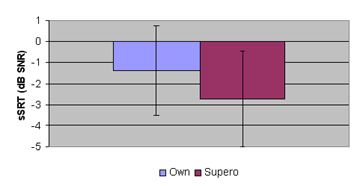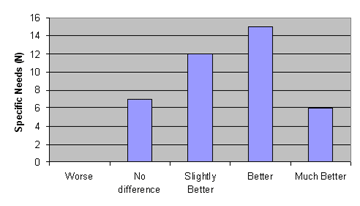Hearing impaired children need hearing aids that provide the most appropriate amplification to develop optimal communication skills. This is particularly true for children with sensorineural severe to profound hearing loss. Children in these categories typically have narrow "dynamic ranges." Reduced dynamic ranges can lead to compromised hearing aid fittings. Great care must be taken when fitting children with amplification. A variety of outcome measures should be employed to appreciate and manage the quality of the fittings.
The performance of a specific digital high power hearing aid in pediatric fittings was evaluated in a controlled field trial. Speech intelligibility in laboratory tests and self-reported benefit in daily life were assessed. Results were obtained and compared for field trial hearing aids and for the children's personal hearing aids. Personal and test hearing aids were set as closely as possible to the same prescriptive formula for each child.
Method and Design:
Ten children, ages 5 to 14 years (mean age: 10.7 years) participated in the study. All subjects were previously diagnosed with bilateral sensorineural hearing loss, ranging from moderate to profound. The PTA across all children was 93.4 dB. Prior to this study, all subjects wore binaural behind-the-ear (BTE) hearing aids. Some had analog aids (N=2) but most had digital devices (N=8). Subjects were recruited from various public school settings within the state of Utah. Their personal hearing aids were previously fitted to various prescriptive targets by their personal audiologists. All subjects' personal hearing aids were functioning within manufacturer's specifications.
The experimental hearing aids were Phonak Supero 412 BTE models used with the subjects' personal earmolds. The Supero 412 is a fully digital hearing aid with a power processing method providing individual shaping across the frequency range for gain and maximum power output (MPO). The flexibility to shape the MPO curve is a feature of the Supero 412 unique in today's market. The Supero 412 is designed specifically for people for whom it is vital to optimize their limited residual dynamic range. A more precise shaping of the MPO curve allows for more utilization of gain at conversational levels. Amplification can be set to linear, Super-Compression or WDRC, respectively, depending on the individual hearing loss, user preference and professional preference. These are multi-program instruments with access to the programs via a manual switch.
The experimental hearing aids were programmed with Program 1 set for quiet listening situations and Program 2 set for noisy listening situations.
Fitting method:
Personal and experimental instruments were set as closely as possible to each subjects' Desired Sensation Level (DSL) targets for gain and MPO. Real Ear to Coupler Differences (RECDs) were included in the pre-calculation. RECDs were measured with each subjects' personal earmolds, in each of their ears, using an Audioscan RM500.
After fitting the instruments, subjects were given a one month period of acclimatization, wearing each set of instruments full time. Upon conclusion of the acclimatization period, objective and subjective tests were conducted with the subjects' personal and experimental hearing instruments.
A range of objective and subjective tests were presented. Objective measures of speech understanding were obtained in quiet and in noise. Speech intelligibility in quiet for eight subjects was determined using the PBK 50 (List A) at 50 dB HL at zero degrees azimuth, yielding a percent correct score. For children unable to perform the PBK due to lack of auditory skills, the closed-set WIPI test (Word Intelligibility by Picture Identification) in quiet was administered. The WIPI test is a multiple-choice, closed-set test requiring the subject to point to one of six pictures for each response (Ross & Learman, 1971). To test speech understanding in noise, Pediatric Speech Intelligibility (PSI) recorded sentence materials were used in Format I (Jerger et al., 1980). Sentences were presented at zero degrees azimuth at 60 dB HL, while recorded multi-talker babble was also presented at zero degrees azimuth. The multi-talker babble was presented at varying presentation levels to adaptively determine the "sentence Speech Reception Threshold" (sSRT), indicating the Signal-to-Noise Ratio (SNR) at which 50% of the sentences could be correctly repeated (Nilsson, Soli, & Sullivan, 1994).
To assess subjective differences, two inventories were administered. The Children's Home Inventory for Listening Difficulties (CHILD) questionnaire, developed by Anderson and Smaldino (2000), was used to measure real-world listening performance with the subjects' personal and experimental hearing aids. Fourteen of the fifteen questions were scored from zero to eight points, with more points indicating more successful listening.
The second inventory administered was the Client Oriented Scale of Improvement (COSI) developed by Dillon et al. (1997). In this inventory, the subject effectively writes the self-report questionnaire by nominating up to five ranked listening situations in which help with hearing is required and their results were evaluated over time.
Speech test results:
The PBK speech test in quiet showed an advantage for the experimental hearing aids for soft speech input, and comparable performance for higher input levels (Fig. 1). Two subjects were unable to perform the open set PBK test (due to a higher degree of hearing loss and lower degrees of auditory skill) and were administered the closed set WIPI test. One subject did very poorly with both sets of hearing aids. The other benefited from the experimental aids for soft speech input, but degraded in loud speech.
The speech in noise results are shown in Figure 2. Better results were produced with the experimental aids. On average, the improved for the sSRT was 1.3dB.
Self-reported improvement:
The subjective judgments confirmed the speech test results, indicating better performance with the experimental hearing aids.
The CHILD questionnaires were administered to all parents and 8 of the 10 children. Parents and children consistently reported improved hearing in every-day situations with the experimental aids, compared to their personal instruments (Fig. 3). Interestingly, on average, the children's ratings were more positive than the judgments of their parents. However, the ratings the children assigned, and the ratings the parents assigned corresponded well, in general.
For the COSI, eight out of the ten children indicated five individual situations each, which were important for them and where they needed strong support from their hearing aids. Typical situations included, "Understanding speech in a mall," "Watching TV," or "Using the phone."
In direct comparisons for each individual situation, the experimental hearing aids were always judged same or better than their own aids, but never worse (Fig. 4). This was confirmed by the absolute rating of hearing ability in the individual situations (Fig. 5).
Conclusion:
This study evaluated the Supero 412 hearing system, as used by children, with moderate to profound hearing losses. The Supero 412 demonstrated advantageous speech intelligibility test scores and demonstrated self-reported benefit when compared to the users' personal instruments. Subjective comments from children and parents confirmed test results. These findings are especially significant for children with severe to profound sensorineural losses, who have a reduced dynamic range.
References:
Anderson KL, Smaldino JJ (2000). CHILD: Children's Home Inventory for Listening Difficulties. www.edaud.org See also www.phonak.com.
Dillon H, James A, and Ginis J. (1997). Client Oriented Scale of Improvement (COSI) and Its Relationship to Several Other Measures of Benefit and Satisfaction Provided by Hearing Aids. J Am Acad Audiol 8: 27-43
Jerger S, Lewis S, Hawkins J, and Jerger J (1980). Pediatric speech intelligibility test. I. Generation of test materials. International J Pediat Otorhinolaryngol 1980, 2:217-230
Nilsson M, Soli S, and Sullivan J (1994). Development of the hearing in noise test for the measurement of speech reception thresholds in quiet and in noise. Journal of the Acoustical Society of America, 95, 1085-1096
Ross, M. & Lerman, J. (1971). Word Intelligibility by Picture Identification. Pittsburgh: Stanwix House.
Figures:
Fig. 1: Speech intelligibility in quiet for three input levels

Fig. 2: Speech intelligibility in noise. Lower sSRTs indicate better performance in noise.

Fig. 3: Average ratings for CHILD questionnaire from children (top) and parents (bottom).

Fig. 4: COSI: Degree of change with experimental aids, compared to own aids. In total, 40 specific needs were given by the children.


